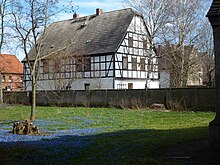Brinnis
|
Brinnis
Community of Schönwölkau
Coordinates: 51 ° 31 ′ 1 ″ N , 12 ° 26 ′ 21 ″ E
|
|
|---|---|
| Height : | 101 m |
| Area : | 77 ha |
| Residents : | 355 (December 31, 2018) |
| Population density : | 461 inhabitants / km² |
| Incorporation : | January 1, 1995 |
| Postal code : | 04509 |
| Area code : | 034295 |
Brinnis is a district of the community Schönwölkau in the district of North Saxony in Saxony . It consists of the places Brinnis, Luckowehna and Wannewitz.
geography
Brinnis is located between the cities of Eilenburg and Delitzsch on the district roads 7443 and 7446, which connect the place with Delitzsch and the federal road 183a . The Brinnis district includes the places Luckowehna, southeast of Brinnis and Wannewitz, northeast of Brinnis. The Halle – Eilenburg railway line runs south of Brinnis . The next train station is Hohenroda .
history
Brinnis is a street village in terms of the type of settlement . The place was first mentioned in 1349 as Brynis . At this time the town of Holdenberg, north of Brinnis, probably already existed . Like most of the region, the name Brinnis comes from Sorbian (basic form Brnišče, Brn ) and means something like “swamp” or “moist soil”. Brinnis and Luckowehna belonged to the electoral office of Delitzsch until 1815 , Wannewitz as an exclave after 1551 to the electoral office of Eilenburg . As a result of the resolutions of the Congress of Vienna , the three places became part of Prussia and in 1816 were assigned to the Delitzsch district in the Merseburg administrative district of the province of Saxony , to which they belonged until 1952. 1950 Luckowehna and Wannewitz were incorporated. In the course of the district reform in the GDR in 1952, Brinnis was assigned to the Delitzsch district in the Leipzig district, which was added to the Delitzsch district in 1994 .
Incorporations
On July 1, 1950, the places Luckowehna and Wannewitz were incorporated into Brinnis. On January 1, 1995, Brinnis merged with four other communities to form the community of Schönwölkau.
Population development
| year | Residents |
|---|---|
| 1818 | 298 |
| 1895 | 341 |
| 1925 | 396 |
| 1939 | 319 |
| year | Residents |
|---|---|
| 1946 | 654 |
| 1950 | 933 |
| 1964 | 560 |
| 1990 | 422 |
The population of Brinnis' was just under 300 in 1818. Until the outbreak of the Second World War , the population rose with slight fluctuations to 319. After the end of the war, the population doubled. In 1946 there were 654 inhabitants. In 1950 there was the historical high of the population with 933. During the time of the GDR the population decreased again by more than half. In 1990 just over 400 people lived in Brinnis.
Attractions
The church in Brinnis dates from the 12th century. The church consists of the Romanesque nave and the tower on the west side; In 1518 the church was expanded to include the choir . In 1557 the nave was extended. There were further renovations in 1830, 1914 and 1968. The inventory of the church includes a sacrament house from around 1480, a life-size crucifix and a neo-Gothic pulpit from 1830. A bronze bell from 1782 is still left of three bells.
Web links
- Brinnis in the Digital Historical Directory of Saxony
- Brinnis on the website of the community Schönwölkau
- Private page about Brinnis
Individual evidence
- ↑ Ernst Eichler : Slavic place names between Saale and Neisse. Volume I, VEB Domowina-Verlag, Bautzen 1985, p. 63
- ^ Karlheinz Blaschke , Uwe Ulrich Jäschke : Kursächsischer Ämteratlas. Leipzig 2009, ISBN 978-3-937386-14-0 ; P. 56 f.
- ^ The district of Delitzsch in the municipality register 1900
- ^ Wellaune in the Historical Directory of Saxony
- ↑ Municipalities 1994 and their changes since January 1, 1948 in the new federal states , Metzler-Poeschel publishing house, Stuttgart, 1995, ISBN 3-8246-0321-7 , publisher: Federal Statistical Office
- ↑ StBA: Changes in the municipalities of Germany, see 1995
- ↑ Information on the history of Brinnis in the Digital Historical Directory of Saxony
- ↑ Kirchenkreis Eilenburg: Traces in the Stone - Churches in the Kirchenkreis Eilenburg , Leipzig 1997, ISBN 3-00-001722-4

